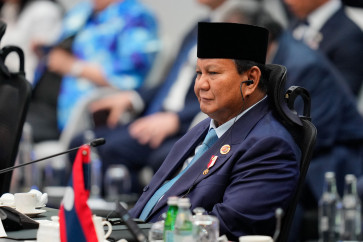Popular Reads
Top Results
Can't find what you're looking for?
View all search resultsPopular Reads
Top Results
Can't find what you're looking for?
View all search resultsIndonesia's health care industry is on the rise
Full implementation of National Health Insurance (JKN) is targeted for 2019 and was initially been seen as the main catalyst to the country’s growth in the health care industry.
Change text size
Gift Premium Articles
to Anyone
D
ata from WHO Global Health Expenditure Database has revealed that, in 2014, Indonesia’s spending on health care totaled only 2.8 percent of GDP. Compared to the global average of 9.9 percent, it goes without saying that our nation’s total expenditure for health is among the lowest in the world.
Full implementation of National Health Insurance (JKN) is targeted for 2019 and was initially been seen as the main catalyst to the country’s growth in the health care industry.
Nevertheless, the initiative saw a challenging launch and, thanks to regulation disparities, poor infrastructure, inadequate medical staff and ultimately funding shortfalls, many analysts maintain their doubts that the program can achieve its main objective, covering 260 million Indonesians by 2019.
While the pain experienced by the majority of Indonesians dealing with Indonesia’s health care may continue to grow for some time, this is a necessary journey toward success and all the bumps can be read as signposts on the road that the nation must travel to higher-income status.
The government has maintained the JKN program as a top priority; hence, the challenges will eventually be overcome.
Moreover, the spark generated by the government’s boost to the health care sector is creating abundant opportunities for all to prosper.
Substandard health care service in Indonesia represent investment opportunities and records have shown surging demand for health and medical services since the JKN program rolled out.
In recent years, Indonesia’s conglomerates have started consolidating and investing heavily in the hospital business.
The likes of Siloam (backed by Lippo Group) and Mitra Keluarga (affiliated with Kalbe Farma) are leading players in Indonesia’s hospital industry. Both have aggressive growth strategies.
According to a report by the Oxford Business Group, Siloam plans to reach total capacity of 10,000 beds with 22 new hospitals coming online by 2017, while Mitra Keluarga has raised US$372 million through one of the largest initial public offerings (IPO) in recent years, the funds will be used to expand its hospital network to 18 by 2020.
Foreign players also find Indonesia’s market very captivating. Foreign investment limits in the hospital business have recently been revised to a level of 67 to 70 percent, so more international hospital groups can be expected to leave their footprint in Indonesia soon.
The limits in the pharmaceutical industry are even higher: 85 percent, and given the estimation that 20 percent of total health expenditure will be allocated to pharmacy products, it was not an exaggeration when in 2015 Frost and Sullivan named Indonesia as “the most promising emerging market for pharma”.
Another area that represents an exciting prospect for investment is stem cell therapy, already an important health commodity in countries like Russia, China and India.
While this is certainly a new area for most investors, the potential revenue is huge, surpassing $18 billion according to a study by the Prodia Group.
Along with economic incentives, this area will promote greater international collaboration that will be useful in the advancement of medical technology in Indonesia.
Perhaps the talk of positioning Indonesia as one of the world’s leading destinations for medical tourism is not a wild dream anymore.
Indonesia may be playing catch up for now to the likes of Singapore and Malaysia in ASEAN, nonetheless, it is not too late to start gaining credibility in international markets like Australia, where higher medical costs may force patients to search for more affordable, but still reliable, treatment overseas.
Indonesia’s health care providers, hence, must prepare themselves to conform to international standards in order to win the hearts of potential foreign patients.
Indonesia’s health care industry is expected to be worth more than $50 billion by 2020. With the influx of foreign players and the race of local players to shift gear in preparation for faster growth, the government must take an active role to ensure the upgrades to the nation’s health care are beneficial for all people of all statuses.
Various investments in the industry must make health care more affordable and accessible, especially for those in less developed parts of Indonesia.
In addition to the primary benefit of delivering adequate health care to the people, the government must also ensure the “side effects” that could potentially also have a larger impact on society in the long run.
Multinational medical companies operating in the domestic market should be persuaded to develop in-country research and development centers and collaborate with local universities to train capable future human resources.
Even the tech and startup industry can make the most of this bloom by exploring various value-added services that offer faster information access, easier interaction, better and strong enough to disrupt the industry.
This wave has already started with the creation of medical portals, real-time health trackers and even the utilization of artificial intelligence that can help medical practitioners diagnose patient health.
***
The writer is a business tech consultant and investment practitioner living in Jakarta.
---------------
We are looking for information, opinions, and in-depth analysis from experts or scholars in a variety of fields. We choose articles based on facts or opinions about general news, as well as quality analysis and commentary about Indonesia or international events. Send your piece to community@jakpost.com. For more information click here.










